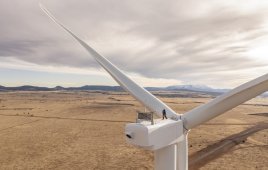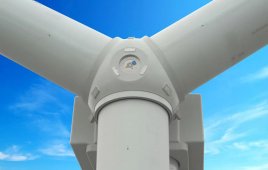Energy company General Electric (GE) recently unveiled the five innovation award winners of its $200 million open innovation challenge, the “GE ecomagination Challenge: Powering the Grid.” The Challenge, launched in July, is part of GE’s commitment to accelerate development of the next generation power grid and global energy transformation through open collaboration.
The five award winners submitted ideas that could contribute to creating a smarter, cleaner, more efficient electric grid and represent the entrepreneurial spirit of the challenge. They were selected by an independent panel of judges including challenge advisor, Wired magazine editor Chris Anderson, GE executives, and leading academics and technologists. Videos of the winners are available at www.ecomagination.com/announcements.
The winning ideas include a lightweight inflatable wind turbine; a technology that instantly de-ices wind turbine blades so they never slow or shut down; an intelligent water meter that can generate its own power; a cyber-secure network infrastructure that allows two-way communications grid monitoring and substation automation from wind and solar farms; and a technology solves short-circuiting and outages from overloaded electric grids by enabling precise control over their flow and power.
The Challenge generated nearly 4,000 ideas and facilitated conversations across the open innovation platform between 70,000 entrepreneurs in more than 150 countries over a 10-week period. GE partnered with four venture capital firms, Emerald Technology Ventures, Foundation Capital, Kleiner Perkins Caufield & Byer and RockPort Capital, to conceive and implement the challenge, calling for innovation ideas in three categories: Renewables, Grid and Eco Homes/Eco Buildings.
“We launched the Challenge to encourage new thinking and spur innovation at every level of development,” said Beth Comstock, senior vice president and chief marketing officer, GE. “The first step toward modernizing our grid is to uncover ideas and transform them into game-changing technologies, and the challenge has demonstrated that many great ideas exist out there. The smart thinking and compelling business cases presented make these innovation award winning ideas examples of pioneering entrepreneurship.”
The five innovation Challenge award winners will each receive $100,000 to develop their ideas. They are:
Capstone Metering: Intelligent Water Meters — Carrollton, Texas: Capstone Metering applies remote communications technology to the century-old water meter. The company’s IntelliH2O is self-powered and delivers real-time water system management, which helps conserve water and eliminates the need for manual meter-readings.
ElectricRoute: Secure Communications Network for the Electric Grid, Salem and Hollis, New Hampshire: Recognizing the substation’s unique location in the electric grid, ElectricRoute created a communications gateway point for transmission and distribution systems. Its cyber-secure, communications network infrastructure eliminates duplicate sensors and thousands of copper lines running inside the substation.
GridON: Controlling Power Quality in Electric Grids, Givatayim, Israel: – GridON created a fault-current-limiter to protect the electric grid from disruptions and power outages, increasing the grid’s reliability and enabling load growth and generation expansion from alternative energy sources. This technology was developed in collaboration with Bar-Ilan University and Ricor Ltd.
IceCode: Wind Turbine Blade Anti-Icing and De-Icing, West Lebanon, NH – Seeking to break one of nature’s strongest bonds, IceCode’s technology removes ice by using high-power pulses to apply heat from the inside out. Employing this technology for wind turbines substantially reduces the amount of energy used for de-icing and eliminates downtime for ice removal and inspection. Developed in collaboration with Dartmouth College.
WinFlex: Inflatable Wind Turbines, Kiryat Yam, Israel: – WinFlex produces rotors for wind turbines from light, flexible and inexpensive cloth sheets made out of composite materials. This flexible rotor design reduces installation costs by at least fifty percent and shortens the return on investment to three-four years, without subsidies.
Chris Anderson said, “Our grids today are where the Internet was a generation ago, with their full interactive potential still largely untapped. Just as we did with the Internet, we can make them smarter and more efficient, using the power of collaboration, open access, and a hugely expanded range of entrepreneurs. The Challenge was designed to accelerate this, and show that good ideas can come from anywhere. And the number and breadth of ideas we received was indeed inspiring.”
GE www.ge.com
Filed Under: Turbines





